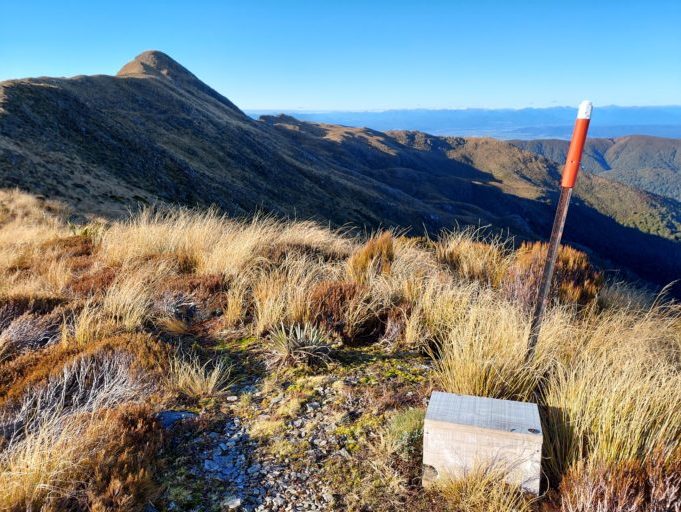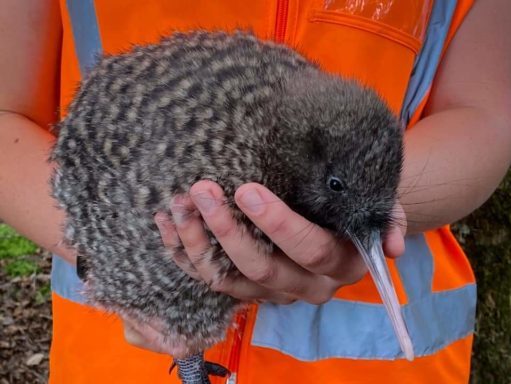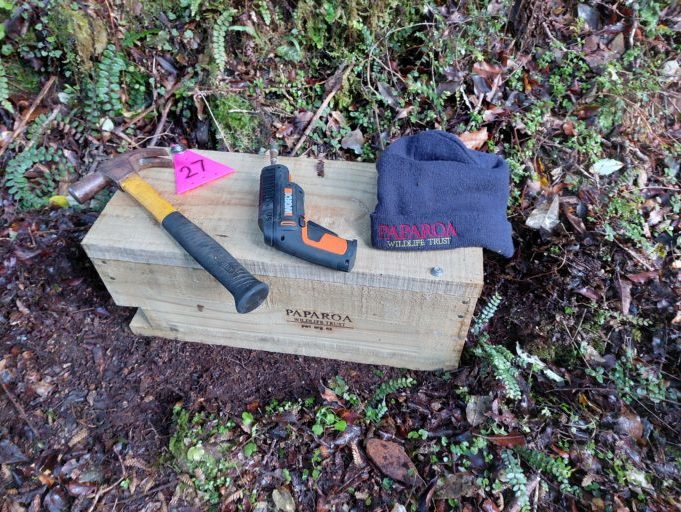The Paparoa Wildlife Trust is a small community organisation made up of dedicated locals who are passionate about looking after the roroa (great spotted kiwi) in their backyard.

Since 2006, the Paparoa Wildlife Trust has been running a trapping programme in the southern Paparoa Ranges, north of Greymouth on the West Coast. Today, it is a substantial project with over 1,600 traps protecting 10,000ha from introduced predators such as stoats, weasels and rats.
And the mahi is paying off! The local population of roroa (great spotted kiwi) and whio (blue duck) are recovering and breeding.
We are speaking to Glen Newton, the project manager at the Paparoa Wildlife Trust. Thank you for speaking with us today, Glen.
Firstly, what does the Paparoa Wildlife Trust do?
We undertake conservation work in the southern Paparoa Range with a focus on roroa. We monitor pairs for breeding success, undertake Operation Nest Egg, complete call counts and acoustic monitoring to establish roroa distribution. This work takes place alongside our trapping project which targets stoats through a landscape-based predator control network.
What is special about the Paparoa Range?
The Paparoa Range is wedged between the Tasman Sea and the Grey/Inangahua Valleys and forms a continuous range upto 1525m high between the Grey and Buller Rivers. In the west it has a spectacular coastline with rich coastal forest, karst landscapes including limestone cliffs, canyons, caves and underground streams. The pancake rock stacks at Punakaiki are very popular with visitors to the area. In the east it is drier (by West Coast standards!) adding to the diversity of landscapes and habitats. It is a significant stronghold of roroa and many other remnant populations of taonga species still exist including whio, kea, kaka, kakariki and kārearea.
The Paparoa Range also has a rich human history focused on gold and coal mining and you can still see remnants of the gold-mining days if you visit the area. In the 1860s, gold was discovered on the West Coast and this sparked a gold rush and a sudden influx of European settlement.
In the late 1800’s the Croesus Track was constructed to allow better access to mines in Blackball Creek and the first part of the newly formed Paparoa Track follows this.
This is New Zealand’s most recent Great Walk and it was developed as a memorial to the men lost in the 2010 Pike River tragedy. Work was undertaken by the Department of Conservation in partnership with the families of men lost and Ngāti Waewae with the track showcasing much of the Paparoa Range and National park.

Great spotted kiwi (roroa) are the largest of our kiwi species and are only found in the top half of the South Island. Why are they only found here and why are roroa worth protecting?
Roroa were once widespread across much of the South Island, being found on the West Coast all the way from Greymouth north along the Paparoa Range, through Westport up to northwest Nelson as well as Arthur’s Pass. They have slowly disappeared from many areas and are now restricted to the Paparoa Range, Northwest Nelson, Westport and Arthur’s Pass. Adult roroa have high survivorship and live for a long time with a life expectancy of 50+ years!
Unfortunately, roroa chicks are vulnerable to stoat predation and unprotected populations are slowly declining as the number of chicks being recruited into the population isn’t sufficient to replace adults as they die.
The Paparoa Wildlife Trust’s Friendly Forest Kiwi Crèche is a safe predator-free enclosure where young kiwi spends a trouble-free year before being released into the wild. What’s it like running a kiwi crèche?
Running a kiwi crèche is an exciting and rewarding business. The crèche is a bit like a fortress, constantly being monitored for potential predator incursions and traps are stationed like guard towers all along the outside of the predator-proof fence. Our kiwi ranger lifts eggs from kiwi pairs in the wild, where they can be eaten by predators, and sends them to Willowbank Wildlife Reserve to finish incubation in a specially designed captive facility. Once the chicks hatch and are putting on weight consistently, they are picked up and driven to the crèche.

For the first few days our kiwi ranger checks to make sure the kiwi chick is hiding properly from avian predators in its new outdoor bush home. The kiwi ranger leaves the chick supplementary food each evening until it starts gaining weight, to ease the transition from captivity to the wild. The kiwi ranger repeats the feeding and checking of each kiwi chick that comes into the crèche.
Our crèche is just over 12 hectares and could comfortably fit up to 8 kiwi chicks. Every month the chicks in the crèche are tracked and found in their burrows where they are weighed and health checked, as well as having their transmitters checked and moved to the other leg.
Once the kiwi are over 1200 grams they are relatively predator-proof and can be released into the wild, adjacent to other kiwi populations. To find a perfect release spot the kiwi ranger completes acoustic surveys to make sure there aren’t too many territorial adults around and explores the terrain to make sure kiwi can be easily monitored after release.
Running a kiwi crèche includes a lot of jobs. Sometimes you find yourself taking a group of students in to learn about kiwi and help with health checks, other times you are planting native trees, feeding kiwi, checking the fence, removing stoats from the perimeter traps, and running tracking tunnels to check what animals are inside. A few times a year you even have to hand mince raw ox heart and make a nice mushy mix of peas, corn, cat biscuits and heart for the kiwi to eat if they need it!
The highlight is releasing the kiwi into the wild knowing you have raised the birds successfully and they can live safely in the wild.
The Paparoa Wildlife Trust’s newest project is focused on expanding predator control north from existing operations towards the Pike Stream, with the eventual goal of getting the area predator-free. How is this progressing?
This is a very exciting time for the Trust! To date our existing trapping methodology has been to focus on our core operations and as funding has permitted us, to expand through slow incremental steps into new areas. The opportunity of Jobs for Nature funding support from Kiwis for kiwi has allowed us to widen our horizons and contemplate a much larger scale expansion of our trapping network over a relatively short period of time. To date this year we have engaged 3 new contractors to work toward our goal to suppress predators from an additional 7,500 hectares of the Paparoa Range. These contractors will support our existing team of trappers who are working alongside a core of volunteers who are all very passionate about predator control. Together we’re working to improve our current predator control measures and implement more effective trapping. To date, we have installed another 150 traps protecting 1,422ha of roroa habitat adjacent to Kinsella Peak and Blackball through sustained mustelid control.
What is the most rewarding part of being involved in this conservation project?
Being part of a small, local community conservation group that has come together to work on this project, along with the support of the local farming community whose properties front our trap network.
They not only allow us access but they also have traplines along the bush margins on their properties. The growing social awareness of the benefits to our taonga through undertaking predator control is exciting.
What is the toughest issue that the Paparoa Wildlife Trust faces?
Our work is ongoing and needs continued funding support to maintain momentum.

To date, we have been very fortunate and have had a long-term commitment from local businesses and volunteers to keep our work going. We were also very fortunate to have our application for Jobs for Nature funding approved, which is helping to supercharge our efforts to become predator-free. We need to keep identifying new funding opportunities to allow us to maintain and expand our work.
The Paparoa Wildlife Trust hosts open days. What can people expect if they come along?

They can expect a real educational experience when the kiwi crèche is opened to the public during our open days.
They will gain an appreciation for the work needed to construct, maintain and keep healthy kiwi within the kiwi crèche.
They will get to talk first hand with our kiwi ranger and most importantly get to see one of our roroa.
The Paparoa Wildlife Trust has an active group of local volunteers. Why do you think people should get involved in local conservation projects?
It’s a great way to learn more about and connect with your own backyard, and the taonga species living there. This has great benefits in terms of personal well-being, satisfaction, and health and fitness from doing the mahi.
How can people support the Paparoa Wildlife Trust?
There are lots of different ways you can support the work we do. You might have some spare time and be keen to check some traps. You might want to visit the kiwi crèche during one of our open days.
If not able to volunteer time you could sponsor a trap or even a whole trapline if you have a business. It costs us $100 to build our traps and $50 a year to service them.
Following our work via social media and telling others about the work we do is another great way to support us.

